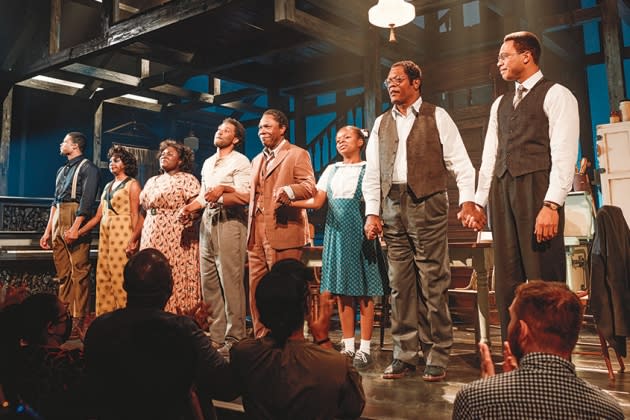Broadway Kicks Off Fall Season With High Hopes and Lingering Uncertainty

Broadway hasn’t been the same since the pandemic. Just consider “The Phantom of the Opera.”
The recent closing announcement of the landmark long-runner underscored just how unpredictable the Street has become after the interruption of the 18-month shutdown and a bumpy restart.
More from Variety
Broadway's Cort Theatre Renamed in Honor of James Earl Jones
Lea Michele Has COVID, Will Return to 'Funny Girl' on Sept. 20
Over the summer, sales and attendance picked up promising momentum, and the 19 new productions that will open between Oct. 1 and the end of the year represent a lineup as robust and varied as any prior to lockdown. But backers of incoming shows know Broadway is still navigating the pandemic’s aftermath, including seemingly enduring shifts in production considerations, consumer lifestyles and buying habits.
No one is quite sure how much longer it will be before things return to normal — or even what “normal” looks like anymore.
“Last season, I feel like we were waiting for this moment when all the airlines were going to be back up and running smoothly, and every hotel would be busy, and COVID would basically be nonexistent,” says Brian Moreland, the producer of the Samuel L. Jackson-led “The Piano Lesson” and new play “Ain’t No Mo’.” “That was going to be the perfect window to resume life as we knew it. And that window never came.”
City agencies put Times Square foot traffic at more than 85% of what it was pre-pandemic, and NYC & Co. projects a 207% bump in international tourism this year versus 2021. That’s good news — but the numbers still don’t match 2019 stats, especially when you factor in the ways that hybrid work schedules have changed how many people come into the city each day and how often.
“I think what shows are going to face this fall is a city that’s not fully back, and an audience whose lifestyles have changed,” says Tracy Geltman, the general manager of New York theater operations for the TodayTix ticketing platform.
The fall schedule seemingly encompasses every style of Broadway specialty. There are large-scale new musicals based on well-known films (“Almost Famous,” “Some Like It Hot”) and the song catalogs of popular music acts (Neil Diamond in “A Beautiful Noise,” Max Martin in “& Juliet”). There are transfers of Off Broadway buzz magnets (“Kimberly Akimbo,” “KPOP”). There are prestige plays (Tom Stoppard’s “Leopoldstadt”), star-driven revivals (“The Piano Lesson” with Jackson) and unexpected takes on classics (“Death of a Salesman” with a Black Loman family, “1776” with an all-BIPOC, all-femme cast). There are Pulitzer winners, solo shows and even a new version of that old chestnut “A Christmas Carol.”
And those are just the titles that managed to score a theater. For almost every venue, there’s a show — or two or three — waiting in the wings for a spot.
That, at least, means the supply side of the Broadway equation looks healthy. Whether consumer demand can sustain all those shows remains to be seen.
According to figures compiled by The Broadway League, available seats were filled to an average of 86% capacity during the first 16 weeks of the 2022-23 season thanks to out-of-town visitors. “Domestic tourism was the big surprise,” says Charlotte St. Martin, president of The Broadway League. “Over the summer we saw a stronger return there than anticipated.”
But this year’s totals still don’t quite measure up to the last full summer on record, 2019, when houses filled to an average capacity of 91%. (It’s an imperfect comparison versus 2022 due to seasonal differences in total number of playing weeks, but one that offers a broad snapshot of audience demand.)
Producers, meanwhile, are contending with shifting tides in advance ticket sales, an important factor in assessing a production’s health and planning for its future. In an atmosphere of ongoing uncertainty, producers of long-running shows say that consumers are buying tickets as little as four to six weeks before a given performance.
That means less breathing room for productions, even as costs are increased by the need for a deeper pool of understudies, alternates and backups to cover any cast and crew absences prompted by still-not-uncommon COVID outbreaks.
For audiences, vaccination is no longer required and, as of July 1, masking is optional, except at individual productions (like “Cost of Living,” opening Oct. 3) that choose to require it.
Busy as the fall is, the schedule isn’t as suffocating as it was in April, when the usual traffic jam of shows vying to open before the Tony eligibility cutoff was compounded by a simultaneous influx of productions that had delayed their openings in the wake of omicron.
Even so, with all the productions circling for spots, you can bet that if there’s an empty theater, it won’t go unfilled for long — making the market as competitive as ever.
“Why do we do that?” one Broadway producer bemoans. “Does Broadway abhor a vacuum?”
Best of Variety
13 Supporting Actors Who Successfully Campaigned for Lead Categories at the Oscars
Your Pet Can Be Anyone They Want This Halloween, From Maverick to Winifred Sanderson
From Maverick and Rooster to Vecna and Eleven: The Best Couples Costumes to Wear This Halloween
Sign up for Variety’s Newsletter. For the latest news, follow us on Facebook, Twitter, and Instagram.
